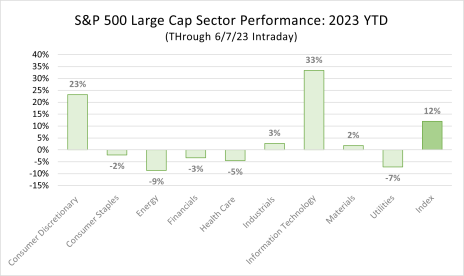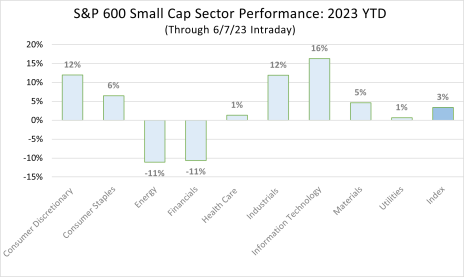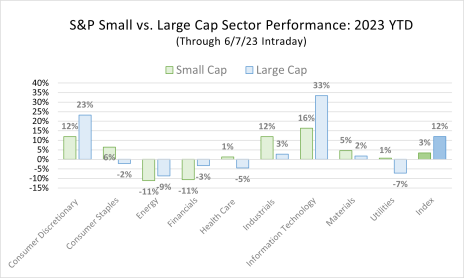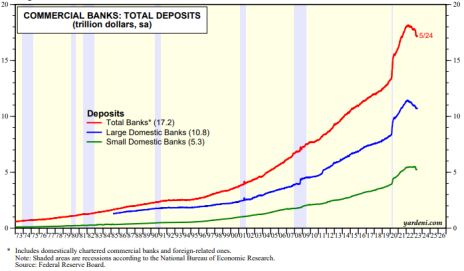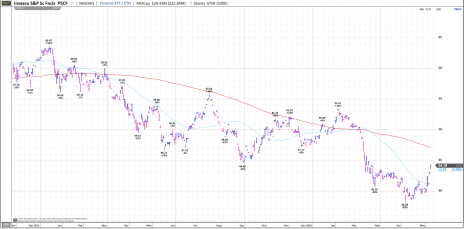Small caps are dramatically underperforming year to date (YTD). That might just spell opportunity for investors that can pull their attention away from the gravitational pull of mega-cap tech stocks.
Consider this.
Through mid-day Wednesday the Nasdaq is up 32% YTD (using December 30, 2022, as a starting point).
The S&P 500 Index is up 11.5%.
Both have been helped, to varying degrees, by the strong performance of the mega-cap tech stocks, Microsoft (MSFT), Apple (APPL), Alphabet (GOOG), Amazon (AMZN), NVIDIA (NVDA) and Meta Platforms (META).
Those six stocks have a combined weight of around 23% in the S&P 500 and … wait for it … around 47% in the Nasdaq.
[text_ad]
Meanwhile, the Russell 2000 Small Cap Index is up a mere 7%. And the S&P 600 SmallCap Index is up just 5%.
Move even further down the market cap curve and it gets worse. The Russell Microcap Index is up 2.4%.
What the?
I’ve discussed this relative performance in previous updates to subscribers of Cabot Small-Cap Confidential and Cabot Early Opportunities.
The high-level reason is simple – it’s because index weighting in the Nasdaq and S&P 500 grossly favors the aforementioned mega-cap stocks. Which are doing fantastically well this year.
But that doesn’t tell the entire story. To really understand what’s going on, and see what’s needed for small-cap stocks to catch up, we need to dig deeper.
The following performance tables for the large and small-cap indices show at a glance what I’m talking about. Let’s start with large caps.
As you can see, when it comes to large caps, the performance has been entirely driven by technology (28% weight) and consumer discretionary (10% weight) stocks.
Now, small caps.
Looking at small-cap stocks, technology (14.6% weight) and consumer discretionary (13.7% weight) are also the largest performance contributors. But industrials (17.8% weight) and materials (5.6% weight) are outperforming too.
The “problem” is the relative performance and higher weight of large-cap tech and consumer discretionary is just that much more powerful. And for small-cap stocks, the heavy weighting and big underperformance of financials (15.7% weight) and, to a lesser degree, energy (4.3% weight), are holding the small-cap index back.
Combining large and small-cap YTD performance by sector in the following chart helps to pull it all together.
The takeaway here is that, yes, the dramatic outperformance of mega-cap tech stocks is driving the bulk of large-cap versus small-cap outperformance. But there are areas where other stocks are doing well too. It’s just that these sectors/stocks are living in the shadow cast by the mega-caps.
So, what do we do with this information?
Well, the bottom line is that for the emerging “bad breadth” bull market to transition into a healthy bull market we need to see more participation from underperforming sectors.
For large caps that means consumer staples, energy, financials, health care, and utilities. At the same time, we need tech and consumer discretionary to not give back too much of their YTD gains.
In small-cap land, yes, energy and financials need to get in gear. But, in my view, financials are really the key.
That’s because the small-cap financial sector is where all the community and regional banks live. And stating the obvious, it’s hard to see a healthy broad market rally take shape if investors and consumers don’t have confidence in the thousands of small banks that are scattered across the country supporting the economy.
At the end of the day if you want to watch one thing that could determine the health of the broad market (disclaimer: we all know there’s no single indicator of market health out there) keep an eye on the Invesco S&P Small Cap 600 Financial Sector ETF (PSCF).
Yes, I know it’s an obscure ETF that trades on such light volume that most brokers will only let you buy it using a limit order and not a market order!
But still, the underlying reasons behind PSCF’s performance (or lack thereof) mean a lot to this economy, and therefore the market.
Deposits in small domestic banks make up roughly a third of all deposits in the U.S.!
In fact, over the last couple of days, we’ve seen the PSCF come up off its lows. I think that’s a good sign of improving broad market health, even if in the short term we see some bumpiness in the mega-caps that have driven YTD large-cap performance.
You can learn more about what I’m recommending for small-cap stocks, including a recent small-cap AI stock, by grabbing a subscription to Cabot Small-Cap Confidential today.

Learn More

Learn More

Learn More

Learn More

